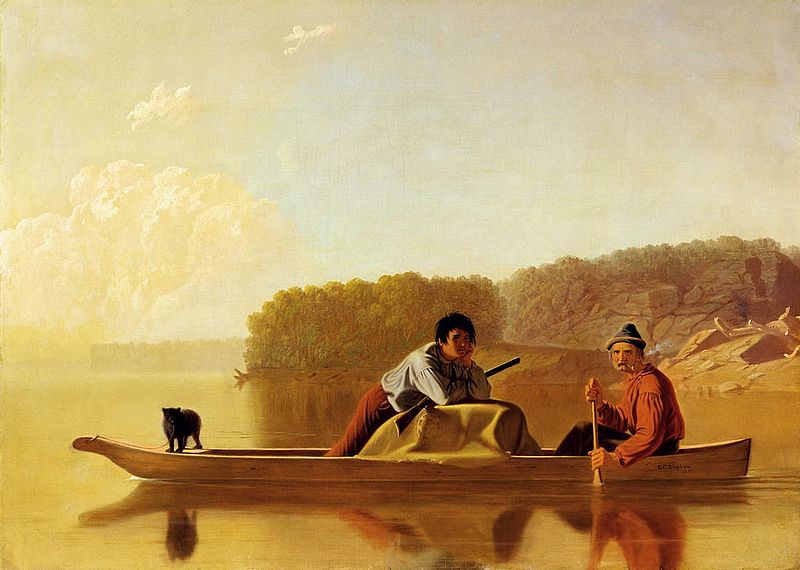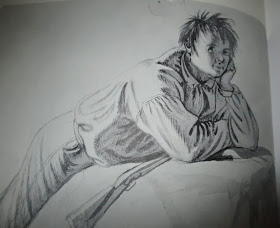
The composition is obviously taken from the earlier painting, but with significant omissions. The snags are missing (the one at the downstream end of the woods may be a snag, or it may be a tree fallen from the forest). The dead duck is gone, as are the hunting bag and rifle case. The bear cub now has appropriately rounded ears but it is in a different position, standing upright rather than looking down its muzzle. The baggage between the bear cub and the boy has disappeared.
Nor are these changes all, for Bingham reworked what he did retain from the earlier painting. The background of woods, cliffs, and shore is different. The father is given a different facial expression, as is the boy. Now, the two seem to be looking at the beholder, observers in their own turn of the audience standing where we are.
Still smoking a pipe, the fur trapper/trader now has a different cap and looks more benign, quite altered from Bingham's earlier painting and his even earlier sketch.
Trying to figure out why I don't care for this version nearly as much as the earlier one, I eventually decided that this one has a flattened quality to it. Its diminished complexity makes it more like a calendar illustration than a painting. There's interesting light, yes; there's an interesting composition, yes; but there's no life in it. The ripples beyond the canoe seem unimportant, with the result that even while the painting represents movement, it seems static. All is calm as we gaze at a nostalgic scene from earlier days. In short, the past has become a version of pastoral, and their journey has become sentimental. It's as if Bingham painted The Trappers' Return with one hand tied behind his back:



As to why you don't care for this as much as the last painting you discussed, it could also be that the proportions in this version seem more off - the boy seems very large in contrast to the trader. You also rightly pointed out that he stares directly at the beholder which is, to my mind, disconcerting in the context of the - distanced? - quality to the rest of the objects in the painting. Thoughts?
ReplyDeleteGood point about the proportions! I'm a bit embarrassed I hadn't noticed this, but you're right. In the earlier painting, the bear cub is staring down its muzzle, but here, it too is staring at the audience. Disconcerting, I agree.
ReplyDeleteIn defense of my preference for a painting which is a "sentimental example of diminished complexity" I will point out a few things. My most exciting discovery was the two hearts in the stone cliffs at the apex of the triangle formed by the rifle and the paddle. This is clearly symbolic. Since Bingham's grandfather and brother both drown in rivers - I suspect these paintings are homages (if not portraits) of them. Unlike other paintings by Bingham illustrating river life, the old man and the boy look out at the viewer, portrait like. Six years later, the boy has grown and the scene is more peaceful. Bingham probably did not have access to an image of the earlier painting but he would have had access to his working drawings. As for the characterization of the latter work as calendar art, I personally would not be surprised to see either painting featured on a calendar.
ReplyDelete